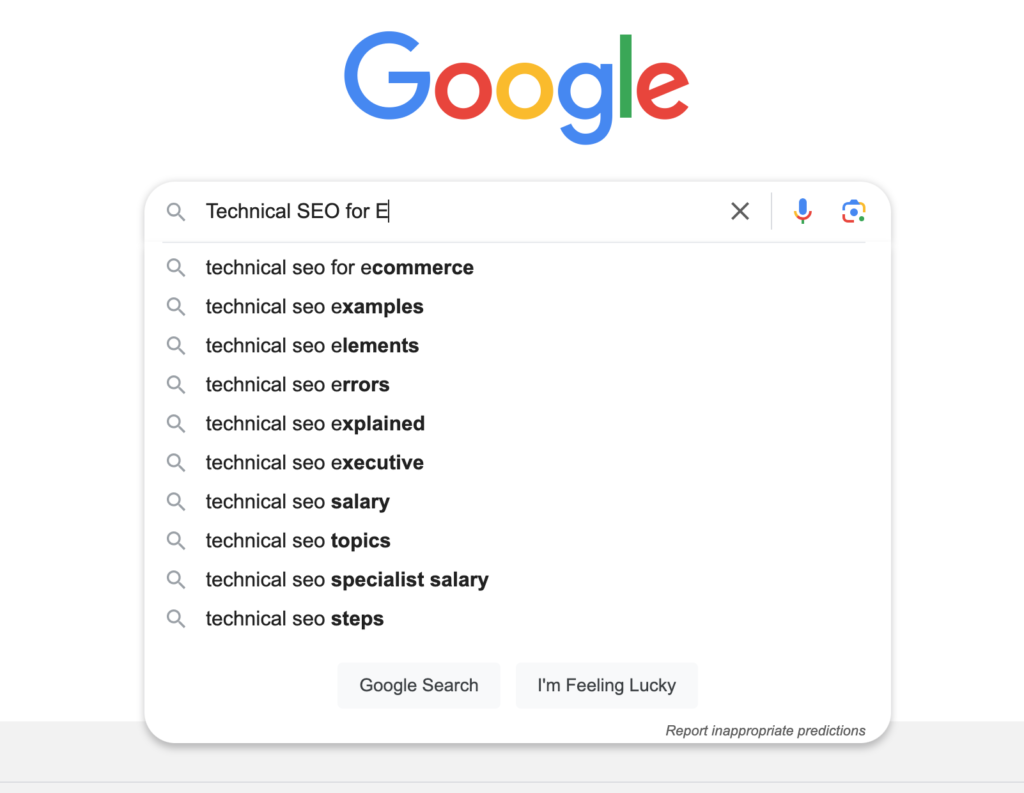
Having a strong SEO strategy for e-commerce websites is critical for businesses aiming to grow and succeed. Whether you run a small online shop or a large B2B e-commerce platform, a well-optimized site can increase traffic, boost sales, and enhance brand visibility.
We will explore the best SEO strategy for e-commerce websites, covering key areas such as keyword research, on-page optimization, off-page SEO, mobile responsiveness, and technical SEO. Let’s dive into effective strategies and trends that will help your site rank higher and attract more customers.
Quick View
Why SEO is Important for E-Commerce?

Search engine optimization is crucial for any e-commerce website. Without SEO, your products may never be found by potential customers. Here’s why SEO is important for ecommerce:
- Increased Visibility: SEO ensures your products appear at the top of search engine results, increasing your visibility to potential buyers.
- Higher Traffic: Optimizing for specific keywords helps drive more targeted traffic to your site.
- Improved User Experience: SEO enhances user experience by improving website performance, navigation, and relevance.
- Long-Term Growth: SEO offers sustainable, long-term results compared to paid advertising.
SEO Strategy for E-commerce Websites

Keyword Research for E-Commerce SEO
The foundation of any successful ecommerce SEO optimization lies in keyword research. Identifying the right search terms helps you target the most relevant traffic.
- Focus on Long-Tail Keywords: Target long-tail keywords that are specific to your products, such as “men’s leather hiking boots” instead of just “hiking boots.”
- Incorporate Buyer Intent Keywords: Use keywords with strong buyer intent, like “buy,” “discount,” or “best.”
- Optimize for Voice Search: As voice search continues to rise, ensure your content matches natural language queries.
On-Page SEO for E-Commerce Sites

On-page SEO involves optimizing individual product pages and content to improve your website’s ranking on search engines.
Optimize Product Pages
Product pages are the backbone of any e-commerce site. Each page should be optimized for search engines and users.
- Product Titles: Create descriptive, keyword-rich product titles that capture search intent.
- Meta Descriptions: Write compelling meta descriptions that encourage clicks and include relevant keywords.
- Unique Product Descriptions: Avoid duplicate content. Write unique, detailed product descriptions for each item.
URL Structure
A clear and concise URL structure is essential for both user experience and search engine optimization.
- Include Keywords: Ensure URLs are descriptive and keyword-rich, making it easy for search engines to index and rank your content.
- Simplify URLs: Keep URLs short and clean, without unnecessary parameters.
Internal Linking
Internal linking improves your website’s SEO by helping search engines crawl your pages more efficiently.
- Link to Related Products: Encourage cross-selling by linking to related products within the same category.
- Use Descriptive Anchor Text: Ensure your anchor texts include relevant keywords for better SEO.
Mobile Optimization for E-Commerce

Mobile traffic accounts for a significant portion of e-commerce visits, making mobile optimization crucial.
- Responsive Design: Your site should be fully responsive, adapting seamlessly to any device or screen size.
- Mobile Page Speed: Optimize mobile page speed using Google’s PageSpeed Insights. Fast loading times are critical for mobile SEO.
- Simplified Navigation: Ensure your mobile site is easy to navigate, with clear menus and a simple product search feature.
E-Commerce SEO Trends and Strategies
Staying up-to-date with current SEO trends will give your e-commerce site an edge over competitors. Here are some top SEO strategies for ecommerce websites in 2024:
Voice Search Optimization
As voice search usage continues to grow, optimizing for natural language queries is becoming more important.
- Target Conversational Keywords: Adjust your content to match conversational queries used in voice searches.
- Create FAQ Pages: FAQ pages can capture voice search traffic by answering common questions in a conversational tone.
Video Content
Videos are highly engaging and can boost both user interaction and search engine rankings.
- Product Demos and Tutorials: Create video content that demonstrates how to use your products or explains their benefits.
- Video SEO: Optimize video titles, descriptions, and tags with relevant keywords to improve your chances of ranking in search results.
Technical SEO for E-Commerce Sites

Technical SEO involves optimizing the backend of your website to improve its performance and ensure search engines can crawl and index your content efficiently.
Site Speed

A fast website is essential for both user experience and SEO. Slow sites lead to high bounce rates and lower rankings.
- Use a CDN: A Content Delivery Network (CDN) helps distribute content and reduces load times for global users.
- Optimize Images: Compress and resize images to speed up page load times without sacrificing quality.
Structured Data
Structured data helps search engines better understand your content and can lead to rich snippets in search results.
- Product Schema Markup: Apply product schema markup to display important information such as price, availability, and reviews directly in search results.
- Breadcrumbs: Use breadcrumb schema to improve navigation and help search engines understand your site’s structure.
HTTPS for Security
Ensure your e-commerce site is secure by using HTTPS. Google prioritizes secure sites, and HTTPS is a ranking factor.
Content Marketing for E-Commerce SEO
Content marketing is an effective way to build authority, drive traffic, and improve your rankings.
- Create Guides and Tutorials: Write helpful guides and tutorials related to your products to establish your site as an authority in your niche.
- Maintain a Blog: Regularly publish blog posts about industry trends, product tips, and buyer guides to keep your content fresh.
- Customer Reviews: Encourage customer reviews, as they provide valuable, user-generated content that helps boost SEO.
Link Building for E-Commerce Sites
Building a strong backlink profile is crucial for improving your website’s authority and rankings.
- Guest Blogging: Write guest posts for authoritative sites in your industry to earn high-quality backlinks.
- Industry Influencers: Collaborate with influencers in your niche to promote your products and generate backlinks.
- Social Media Promotion: Share your content on social media platforms to attract backlinks naturally and increase brand exposure.
Best Layout Practices for E-Commerce Sites

Your website’s design and layout impact both user experience and SEO performance. Follow these best practices for optimal results:
- Simple and Intuitive Layout: Make sure your site is easy to navigate with clear menus, filters, and a search bar.
- Conversion-Focused Design: Use compelling calls to action (CTAs) and optimize the checkout process to maximize conversions.
- Fast Loading Times: Ensure every page of your website loads quickly to improve user experience and SEO.
Summary
A well-executed SEO strategy for e-commerce websites can make all the difference in driving traffic and increasing sales. By focusing on keyword research, on-page optimization, mobile responsiveness, and technical SEO, you can sure your site ranks higher and attracts the right customers.
Additionally, staying up-to-date with the latest trends, such as voice search optimization, video content, and Google algorithm updates, will help you maintain a competitive edge. With the right approach, SEO for an e-commerce site can lead to sustainable, long-term success for your business.
FAQs
How to use SEO for e-commerce?
Optimize product pages by using relevant keywords and fast load times. Focus on meta descriptions, alt tags, and creating unique content. Internal linking between products also helps users navigate.
Is SEO good for eCommerce?
Yes, SEO is essential for eCommerce as it helps attract organic traffic, boosts online visibility, and increases sales without relying on paid ads.
How do I structure an eCommerce site for SEO?
Create a clean, easy-to-navigate URL structure that reflects product categories and keywords. Make sure your navigation is intuitive, and use breadcrumbs to help users. Optimize each page for speed and mobile-friendliness.
What is SEO strategy plan?
An SEO strategy plan is a roadmap that outlines steps to optimize your site for search engines. It includes keyword research, technical audits, on-page SEO, and content development.
What are the best tools for eCommerce SEO?
Google Analytics, SEMrush, Ahrefs, and Moz are some of the best tools for eCommerce SEO. They provide keyword insights, track your rankings, analyze backlinks, and identify technical issues.
What are the 4 types of SEO?
The four types of SEO are on-page SEO, off-page SEO, technical SEO, and local SEO. On-page focuses on content and keywords, off-page involves link-building, technical SEO, making sure your site functions well, and local targets location-based searches.
How to rank an eCommerce site?
To rank an eCommerce site, optimize product pages with relevant keywords, improve site speed, and ensure mobile compatibility.
How do you create an SEO content strategy?
To create an SEO content strategy, identify target keywords, create high-quality content around those keywords, and optimize for user intent. Focus on providing value through product descriptions, guides, and blog posts.
Does eCommerce need SEO?
Yes, SEO is essential for eCommerce to drive organic traffic and increase visibility. It helps customers find your products through search engines and builds brand credibility.




